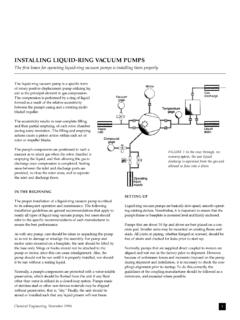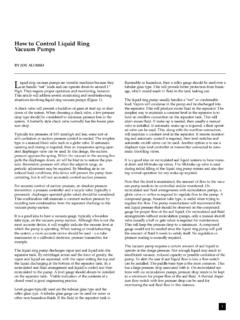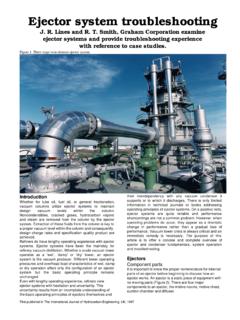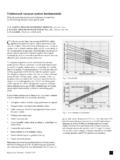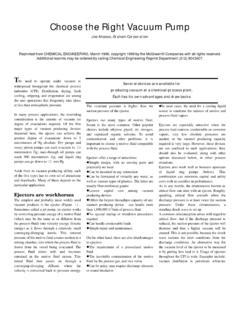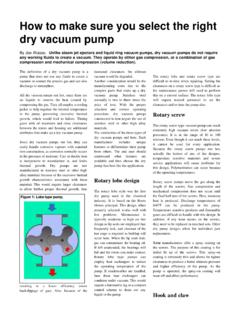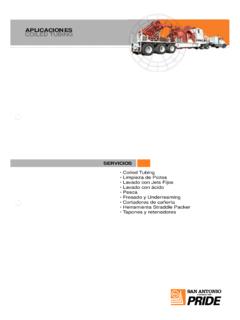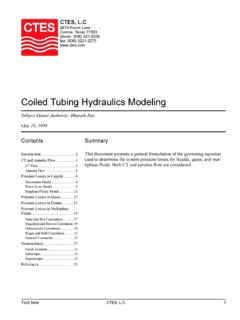Transcription of Helically Coiled Heat Exchangers Offer Advantages - Graham
1 Not all heat Exchangers are created equal. Helical coil units Offer Advantages that too often get overlooked, but they may be ideal for your application. Helically Coiled heat Exchangers Offer Advantages BY JAMES R. LINES. Graham MANUFACTURING CO. INC. P rocess heat transfer with conventional shell and tube heat Exchangers is familiar to many engineers in many industries. Their use and performance is well-documented. Helically Coiled heat Exchangers , although they have been around for many years, are not as well known. Helically Coiled Exchangers Offer certain Advantages . Compact size provides a distinct benefit. Higher film coefficients the rate at which heat is transferred through a wall from one fluid to anoth- er and more effective use of available pressure drop result in efficient and less-expensive designs. True counter-current flow fully utilizes available LMTD (logarithmic mean temperature dif- ference). Helical geometry permits handling of high temperatures and extreme temperature differentials without high induced stresses or costly expansion joints.
2 High-pressure capability and the ability to fully clean the service-fluid flow area add to the exchanger 's Advantages . Although various configurations are available, the basic and most common design consists of a series of stacked Helically Coiled tubes. The tube ends are connected to manifolds, which act as fluid entry and exit locations. The tube bundle is constructed of a number of tubes stacked atop each other, and the entire bundle is Bundle for a water vaporizer in a supercritical water-extraction placed inside a casing, or shell (Fig. 1.) process. (Fig. 1). Vaporizer design for liquid vaporization and droplet disen- FLOW PATH gagement (Fig. 2). Condenser design, which comes in three typical configura- Once positioned in the casing, the assembly forms a helical flow tions. Each depends on the process and vessel's discharge path for both the casing and tubeside fluid. Standard units have connection (Figs. 3a, 3b, 3c). manifold and casing gaskets, although complete welded designs are available for high casing-pressure service or hazardous applications.
3 Weld-seal designs for completely welded units often are spec- ified when cross-contamination must be prevented, or fluids To effectively optimize thermal and hydraulic requirements, the are hazardous or incompatible with gasket materials (Fig. 4). number of tubes (coils) along with their spacing and length may be varied. This allows a design to meet the thermal and hydrody- As with any heat exchanger , the flow rate, allowable pressure, namic requirements of both the casing and tubeside fluids, so physical properties of the fluid, and construction material control users can select a unit that matches their application's thermal final design. demand and hydraulic limitations. No matter the design, helical heat Exchangers Offer several distinct Other available configurations are: Advantages to the user. Multiple pass design, which increases tubeside velocity, there- High film coefficients are achieved on both the coil and casing by increasing the heat transfer rate.
4 With this configuration, side. The helical flow path imparts higher shear rates and turbu- there is an increase in tubeside pressure drop. lence at a given pressure drop, which can result in film coefficients Reprinted from Water/Engineering & Management, September 1991 1. The high shear stresses and induced turbulence of Helically Coiled Exchangers reduce the tendency for fouling. This results in longer operating cycles between scheduled cleaning intervals. Additionally, the lower fouling tendency permits the use of less conservative safety margins at the initial design Stage. Conventional designs allow casing-side access for cleaning and inspection. Economical unit selection is possible due to approved film coeffi- cients, full use of available LMTD and minimal required thick- nesses. LIMITATIONS. There are very few limitations for the use of Helically Coiled heat Exchangers . Generally, a pressure limit of 10,000 psig covers the majority of applications.
5 Temperature limits are determined by construction materials, as are the corrosion rates. Surface areas of 1 to 650 sq. ft. are available, and using units in series or parallel may extend this range substantially. APPLICATIONS. Vaporizer design of a helical heat exchanger for liquid evaporization and droplet disengagement. (Fig. 2) The use of Helically Coiled Exchangers continues to increase. Applications include liquid heating/cooling, steam heaters, vapor- up to 40% higher than those achieved with many comparable izers, cryogenic cooling and vent condensing. Listed below are the shell and tube units. Departure from laminar floss and fully devel- details for standard services in which helical Exchangers warrant oped turbulent flow occur at lower Reynolds numbers. consideration. The 100% counter-current flow allows full use of the available Sample Cooling LMTD and makes temperature cross when the hotside outlet Analyzer Pre-cooling temperature is cooled below the coolside outlet temperature pos- sible without multiple units in series.
6 The flow geometry of a heli- Seal Coolers cal unit is such that a temperature cross is managed within a single Condensers unit. This is possible because 100% counter-current flow permits closer temperature approaches and improved heat recovery. Cryogenic Vaporizers Compressor Inter- and After-Coolers Cleaning the casing-side flow area is easily managed. The casing can be unbolted and the entire bundle assembly removed for General Applications cleaning, inspection or replacement. Fully welded designs (weld- seal) though, do not have this feature. Sample Cooling. Continuous monitoring of process output is nec- essary to ensure product quality within allowable tolerance. Grab- The coil arrangement's compactness also provides Advantages , sample cooling (Fig. 5) is needed prior to transport to lab techni- because the exchanger requires minimal floor space. cians for analysis, so an inexpensive compact unit is needed to efficiently cool sample streams to desirable levels.
7 The heat exchanger 's spring-like coil eliminates thermal expansion and thermal shock problems that often occur during startup or The helical coil design, with definitive flow path for both sample during cryogenic or high-temperature service. and cooling water, provides a counter-current flow design of high efficiency and predictable close-temperature approach. Typical High operating pressures are easily handled on the coilside, and sampling locations are boiler steam, distillation column over- without the need for the tubesheet of a shell and tube unit, heads, reboiler bottoms, condensate drums, distillation column required thicknesses are minimal, even at high operating pres- cut-points and de-aerators. sures. Pressures exceeding 10,000 psi are possible. Boiler steam sampling is often at high pressures and Coiled tube units are not affected by these operating requirements. Reprinted from Water/Engineering & Management, September 1991 2.
8 Condenser design with helical bundle mount inside vessel's discharge flange is typical of reflux-condensing applications. (Fig. 3a). Analyzer Pre-cooling. Many components are processed as liquids at, or near, their boiling points. As the liquid passes through a measuring device there is a loss of pressure, which causes the liq- uid to flash or boil. Measurement devices lose accuracy when handling two-phase flow. Traditional volumetric or velocity meas- uring instruments introduce accuracy uncertainties when measur- ing a two-phase fluid. From the process viewpoint, this is a major problem. Typical liquids, such as ammonia, carbon dioxide, sulfur dioxide, freon and ethylene are processed at their boiling point. Pre-cool- ing the liquid prior to an analyzer may be necessary to ensure that flashing does not occur and measurement accuracy is not com- promised. Many plants install a compact helical heat exchanger in their measurement packages for the purpose of pre-cooling the saturated liquid prior to measuring.
9 By pre-cooling prior to meas- uring, the resulting pressure drop across the measuring device does not result in flashing and two-phase flow. Seal Coolers. Centrifugal pumps require cooling of their mechani- cal seals to ensure reasonable mechanical seal service life. The pump seal liquid absorbs heat generated at the mechanical seal to shaft contact surface, and this heat must be removed. Compact helical heat Exchangers have long been specified for this service, because they can efficiently reject heat absorbed the seal liquid and economically handle the often high operating pressures Condenser design mounted external to vessel is commonly used with of a centrifugal pump. Also, the helical coil may be mounted so it vent-condensing applications.(Fig. 3b). operates as a thermosyphon and thereby complies with the strin- gent requirements of American Petroleum Institute (API) 682. Condenser design with condensing on the tubeside is typical of corro- sive services or when costly process contacted materials are necessary.
10 (Fig. 3c). Reprinted from Water/Engineering & Management, September 1991 3. Two welded units that are nitrogen-purged and blanketed for use in a computer-chip wash application. (Fig. 4). Similarly, helical coil units are used as seal coolers for liquid vacu- um pumps by removing the heat absorbed by the liquid ring a result of heat generated by the pump itself and the heat released by condensing vapors during their compression. Condensers. Helical coil heat Exchangers often are used as con- densers within a process loop, such as reflux condensers or as dis- charge vent condensers at the end of a process. The coil configuration allows for insertion of the tube bundle directly into a distillation tower, storage tank or reactor. This allows vapors flowing up a vessel to contact the cooled tube bun- dle and condense. The condensate that refluxes directly back into the tower may be directed elsewhere. With the bundle inserted directly into the vessel, not only is there a benefit from direct reflux, but also there is the elimination of overhead piping and support structures.
